INDEX
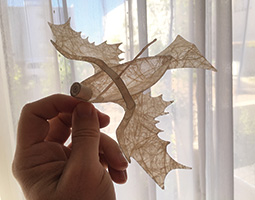
A paper airplane made using Mino washi 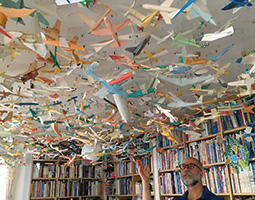
Dewar’s studio at home, decorated with countless paper airplanes 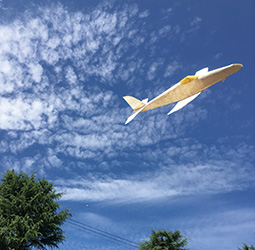
Cricket, a Mino washi glider 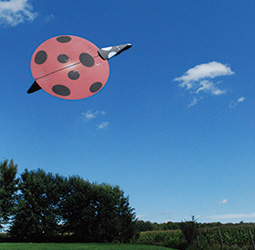
A flying ladybird model 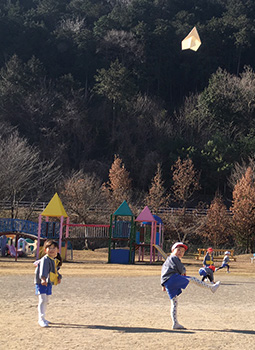
Children flying paper airplanes in the kindergarten yard under Dewar’s supervision
December 2021
A Canadian Flying Paper Airplanes in the Japanese Sky
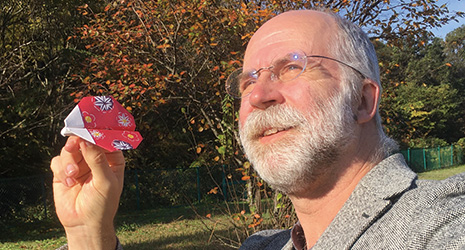
Andrew Dewar, a Canadian fascinated by Japanese paper airplanes, shares his love for the creations with his students in Japan and people around the world.
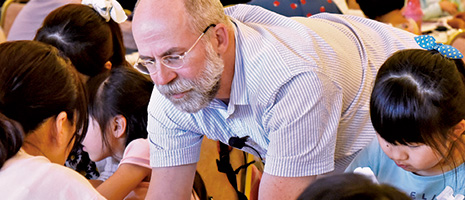
Canadian-Born Andrew Dewar explains that “Paper airplanes, which you can make from folding a single sheet or by combining parts cut from paper, are not just child’s play but have real depth.” A resident of Gifu Prefecture, Dewar works as a professor of library and information science at Tokai Gakuin University, and is the principal of a kindergarten attached to the university. He is also active as a paper airplane artist in Japan and abroad.

Dewar says, “You can enjoy looking at your creations, but the best thing about paper airplanes is that they can fly.” Paper airplanes lack propulsion and fly using just the lift of their wings. They are quite simple, but the planes will not fly unless made in a shape that fulfills the requirements for flying well. Dewar comments, “A neat way of saying the same thing is that a paper airplane flies because the sky allows it to.”

Dewar has created numerous unique paper airplanes. Many of his folding methods run counter to what one would expect, such as being right-left asymmetrical, or three-dimensional with a bulging fuselage. He has authored more than forty books in English and Japanese, explaining how paper airplanes fly and presenting creations that recreate actual aircraft using paper, and is admired in North America and countries around the world.

Dewar first encountered paper airplanes in a book he read when he was a child in Toronto. The book was about the International Paper Airplane Competition in 1967. Dewar was especially fascinated by the paper airplane of Ninomiya Yasuaki from Japan, who won the grand prize. Dewar made up his mind and wrote a letter to Ninomiya in English. Perhaps Dewar’s enthusiasm shone through, because he soon received a reply from Ninomiya along with several books in Japanese with paper airplane patterns. That was the start of contact between Dewar and Ninomiya over many years.
After finishing his graduate studies in library and information science at the University of Toronto, Dewar had the opportunity to study abroad in 1988 and picked Japan. Later, he became a university professor here and still lives in Japan. A major reason why Dewar decided to study in Japan was because he felt that paper airplane making is popular here, with many enthusiasts, national competitions, a variety of books, and an established culture of paper airplanes.

Dewar believes that one reason for the popularity of paper airplane making in Japan is the long history of Japanese paper culture. Gifu Prefecture, where Dewar lives, is home to Mino washi paper, one of Japan’s oldest types of traditional washi paper. Mino washi is thin but also uniform in quality, and has a delicate and beautiful texture. Moreover, because of its high durability, it is popular not only in Japan but also abroad. Dewar also makes beautiful paper airplanes out of Mino washi that take advantage of its attributes, achieving soft forms and letting through faint sunlight.
Dewar runs his own workshops where anyone, young or old, can immerse themselves in making paper airplanes.

Sometimes, Dewar himself has fun flying paper airplanes in the kindergarten yard or nearby parks with the children at the kindergarten where he serves as principal.
He says, “It’s more fun to fly out in nature than to compete indoors over how far you can fly or how long you can stay aloft.” He gently smiles and adds, “You need to look up at the sky and feel the wind when you fly a paper airplane. When the paper airplane returns to the ground, you can find small flowers or mushrooms there. Once in a while it will ride on an updraft and get carried far up into the sky. When that happens, I tell the children that the sky must have wanted to have that plane.” He is filled with affection for paper airplanes, and with a love for Japan’s nature and children.

